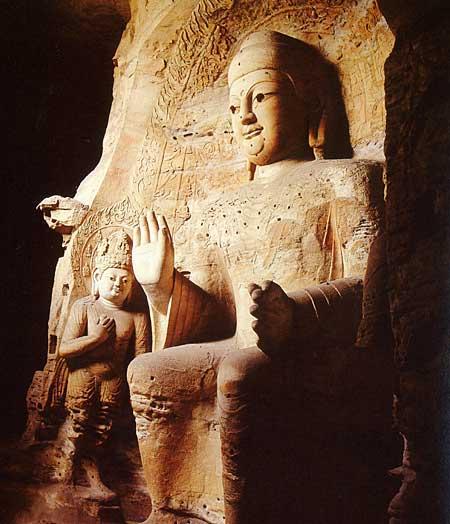
 |
| Yungang Grottoes (CNTV) |
It is also known as the treasure house of ancient Chinese sculpture art. It can be divided into the early, middle and late periods according to the digging time and the carving style in every period was also different. The early "Tan Yao Five Caves" is magnificent and has simple and rustic western styles. The grottoes in the middle period are world-famous for their refined carvings and gorgeous decorations, showing the complex and grand artistic style of the Northern Wei Dynasty. The grottoes in the late period are small but the statues are thin and pretty and have moderate proportions. It is the example of grotto art in northern China and the origin of the "thin and pretty statues" style. In addition, the statues are in a state of dancing accompanied by music and acrobatics carvings also reflect the fashionable idea of Buddhism at the time as well as the social life in the Northern Wei Dynasty. Li Daoyuan, a famous geographer in the Northern Wei Dynasty, had described the spectacular scene in his geography work "Shui Jing Zhu."
The Yungang Grottoes is divided into three parts, with the eastern part having four caves, the middle part having nine caves and the western part having 40 caves. In addition, there are also are many small caves. Among them, there are some distinctive caves and the third cave is the largest among the Yungang Grottoes, with the front bluff being 25 meters high and having 12 square holes in upper center part. The third cave has two rooms, the front room and back room. The back room has one Buddha statue and two Bodhisattvas with smooth cheeks, looking plump and natural. Judging from the carving technique, they were engraved in the Sui and Tang dynasties. The fifth and sixth caves are a group of two caves, with the fifth cave established in the Eighth Shunzhi Year of the Qing Dynasty in 1651 AD. A Buddha, the largest statue in the Yungang Grottoes sits in the center of the fifth cave, and is 17 meters tall and can accommodate 120 people standing on its knee and 12 people standing on its foot. Many small Buddhas surround the largest one, creating a magnificent view.


















 Vehicles, pedestrians fall into river after bridge collapses in SW China
Vehicles, pedestrians fall into river after bridge collapses in SW China


![]()
